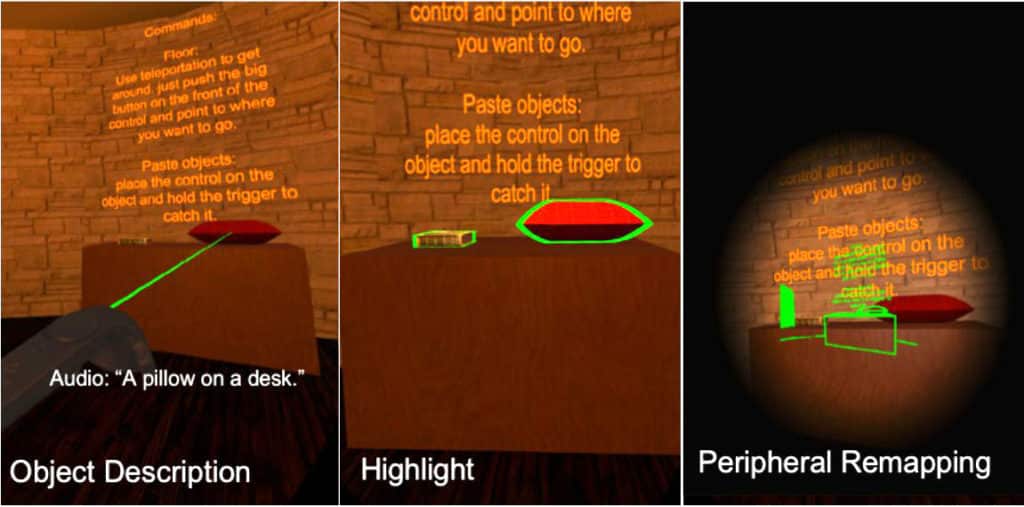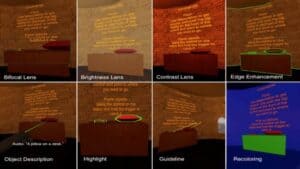A report in Engadget reveals that Microsoft has been working on visual accessibility issues in VR. SeeingVR is an innovative tool kit for Unity developers to help people with low vision. It includes a bifocal lens feature, brightness and contrast controls, a magnifier, along with enhancements for object edges and depth measurement.
This is deeply welcoming news for the medium. Up to now, there’s have been some fascinating projects in this area, but little benefit for end-users. Samsung’s C-Labs created their Relúmĭno app and Google has experimented with a spatial-audio navigation system. Last year, Microsoft showed off their novel Canetroller, a tool to help people with visual impairments navigate virtual environments. All excellent initiatives. But they seem to be more proof of concept than substantive developments.
To Microsoft’s credit, they’ve devoted more effort on accessibility issues than many of their competitors. Take a look at Microsoft Soundscape which is already helping people with low vision navigate the physical world:
. . . [which] explores the use of innovative audio-based technology to enable people, particularly those with blindness or low vision, to build a richer awareness of their surroundings, thus becoming more confident and empowered to get around. Unlike step-by-step navigation apps, Soundscape uses 3D audio cues to enrich ambient awareness and provide a new way to relate to the environment. It allows you to build a mental map and make personal route choices while being more comfortable within unfamiliar spaces.
Visual Accessibility in VR
In a post at Microsoft, Meredith Ringel Morris, Principal Researcher, and Research Manager, said the following:
Low vision (that is, visual disabilities that cannot be fully corrected by glasses) impacts 217 million people worldwide according to the World Health Organization. While desktop software offers some accommodation features for people with low vision (for example, screen magnifiers), VR systems have not yet grappled with the issue of accessibility for this audience. Indeed, when interviewing VR developers, the team found that none had received training or guidance on how to develop accessible VR experiences.
That last statement is appalling but not unexpected. Over the years, we’ve had numerous discussions on accessibility issues but they’ve always been raised by end-users, never developers. Partly it’s due to a lack of tools to address the challenges. And for those working in Unity and other platforms, creating VR experiences in challenging enough. But this is what needs to change.
Morris continues:
Because low vision encompasses a range of visual abilities (for example, tunnel vision, blind spots, brightness sensitivity, low visual acuity, and so on), the team took a toolkit approach—they developed SeeingVR, a set of 14 tools for Unity developers (Unity is one of the most widely-used VR development platforms). End-users can activate different combinations of these tools depending on their abilities and the context of the current application and task.

Microsoft’s work on accessibility issues in VR addresses multiple needs. The tools would be easy to incorporate into virtual experiences. And equally important, they’ll be easy to use for the end-user.
The SeeingVR Toolkit
If you want to learn more about SeeingVR, take a look at their research paper, “SeeingVR: A Set of Tools to Make Virtual Reality More Accessible to People with Low Vision.” It will be presented next month at the ACM CHI Conference on Human Factors in Computing Systems conference in Glasgow, Scotland.
There’s also a seven-minute video highlighting the features in SeeingVR released at the end of last year:
Microsoft is doing important work in this area. If VR is to widely used in entertainment, education, and the workplace, it needs to open doors for everyone, not create barriers.
Emory Craig is a writer, speaker, and consultant specializing in virtual reality (VR) and generative AI. With a rich background in art, new media, and higher education, he is a sought-after speaker at international conferences. Emory shares unique insights on innovation and collaborates with universities, nonprofits, businesses, and international organizations to develop transformative initiatives in XR, GenAI, and digital ethics. Passionate about harnessing the potential of cutting-edge technologies, he explores the ethical ramifications of blending the real with the virtual, sparking meaningful conversations about the future of human experience in an increasingly interconnected world.

